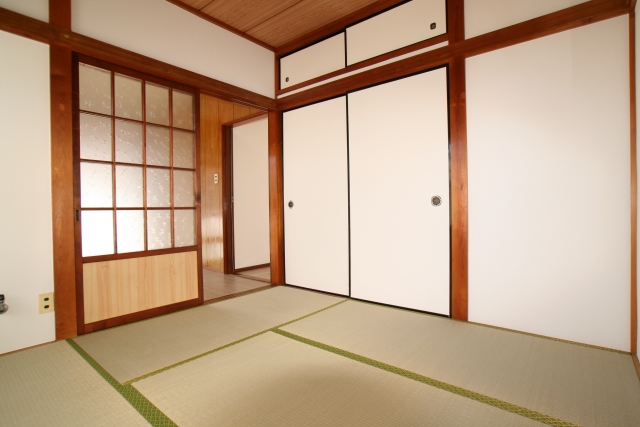A lot of expats have voiced their opinions about their preference for western rooms over Japanese style rooms. One of the reasons can be attributed to limitations of using furniture on tatami mats, as they may damage the surface. Others have voiced concerns over the smell of new tatami mats or unwillingness to sleep on the floor.
In fact, some people actually place rugs or floor paneling over the tatami mats as solutions. They will protect tatami mats from any damage from furniture. And if you wish to do so yourself, we can give you some ideas. However, you should remove the covering and expose the tatami surface periodically for ventilation. The tatami mats are made of straws and easily absorb moisture. If the surfaces is covered for prolonged periods, it will get moldy and even attract bugs ( yuck! ). A damaged tatami mat will require replacement, and this means you’ll need to shell out an extra the day you move out!
Therefore, proper care and cleaning is necessary if you want to keep your tatami mats clean and fresh.

Here are some options
Rugs
They come in many sizes, colors, and shapes, and adds a touch of western decor to your tatami mats. Costs can vary widely from material and size. Best used with beds or tables to lessen the damage to tatami mats.
PROS: If you aren’t too fussy about quality and material, they can be very affordable. They can be easily removed, making ventilation simple. Ease of maintenance and shipment when you move in or out. The smaller the better.
CONS: They only cover a portion of the room.
Room-sized carpets
These are a bit harder to come by, and they are sold at online shops. Most of the stores are only written in Japanese and you might find it a challenge to place an order. They are designed to cover an entire room, and may not fit perfectly into yours. Make sure to measure the dimensions before you purchase.
PROS: If you have the proper dimensions, it will cover the tatami mats entirely. You can place furnitures in the room without worrying about damaging the tatami.
CONS: They can be very expensive compared to certain rugs. Maintenance can be quite a hassle, as you have to move out all the furniture before removing the carpet. Shipment and disposal can be a hassle when you move out.
Floor paneling
Another option you can use. The paneling are interlocking pieces of tiles that you can purchase at DIY shops. Nitori is a popular place to do your shopping. The panels are pretty thick and provide more protection against furniture. They can be cut to match your room dimensions.
PROS: Added protection to your tatami mats. They can be adjusted to fit your room. Ease of shipment.
CONS: Removal and reapplying them can be quite a hassle.

How to care for your tatami mats
Remove your rug or floor panelling at least once a week. Open the windows to expose the tatami mats to fresh air. Exposure to direct sunlight will sterilize the surfaces. If your tatami mats are new, they tend to absorb moisture more easily. On humid days ( particularly rainy season and summer time ), your tatami mats should be exposed more often. Use disinfectant alcohol, or a steam iron to sterilize the tatami mat surfaces. Spray the surfaces with steam, as it will also kill any ticks or beg bugs. Do not iron the surface! If possible, you may want to hang your rug outdoors and let both sides be exposed to sunlight.
Just keep in mind that most Japanese people do not cover their tatami mats, and actually place furniture directly on the tatami mats. There is actually not much functional significance in using rugs or floor paneling on tatami mats, unless it’s your style of preference. The tatami mats have a special cloth called “heri” on the edges, and placing a rug or floor panelling over them may make them uneven.
What makes tatami mats so special?
The younger generation prefer western style rooms over traditional Japanese rooms, and the latter are becoming increasingly harder to come by. However, you will come across Japanese rooms more often in smaller cities. Traditionally, old Japanese homes lacked large furniture, and everything would be put away in a large closet. People may think that this is a pretty troublesome habit, but the sparse decor is what makes the room feel roomier. Tatamis are a lot like carpets and rugs, but without the fluffiness. You can lie down on them. They also absorb moisture from the room. Moreover, rent for apartments with a Japanese style room tends to be slightly cheaper than those with western style rooms. We hope this article will be useful for you when using Japanese style rooms.
If you plan to move to Japan or seek assistance after settling in, please contact us
If you have plans to move to Japan or need help getting settled, we’d be glad to assist you. We can also help you from choosing the right apartment to assisting you with the paperwork, as well as provide support for your everyday life.
For details regarding support, refer to: our services
You can contact us via email:
If you wish to contact us via SNS, click on the LINE logo on the bottom right hand corner of your browser. We can speak Japanese and English.

 CONTACT
CONTACT







